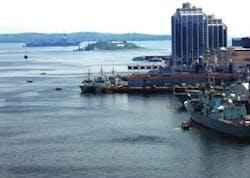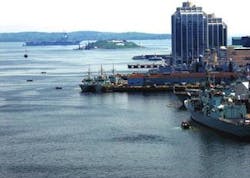Monsters protect Halifax harbor from pollution
JWC Environmental overflow screens will help screen out municipal and industrial pollutants from escaping into the environment.
Canadian contractor Black and McDonald ordered 22 Storm MonsterTM overflow screens from the US company JWC Environmental for a massive sewage treatment project that will serve the cities surrounding Halifax Harbor, including Dartmouth, Herring Cove and Halifax.
During heavy rain storms and conditions that result in sewage overflow the 22 Storm Monsters, each weighing over a ton and some as long as 10 meters, will protect the harbor by screening out municipal and industrial pollutants, discharging them into the downstream sewage flow and preventing them from escaping into the environment.
Storm Monster is a breakthrough technology in the combined storm water overflow (CSO) marketplace and provides outstanding capture efficiency and flow rates in an extremely demanding application. Rotating perforated panels with 6-mm openings capture pollutants and solids and move them to a solid-clad cleaning brush that returns the solids to the downstream sewage flow for processing at the treatment plant.
Robert Burns, the project team leader who heads Black & McDonald’s Harbor Solutions Team in Dartmouth, pointed to two key Storm Monster features. A perforated plate screen provides higher capture efficiency than a slotted bar screen. Solids are moved downstream without removing, conveying or handling screenings, as a raked bar screen would require.
The Storm Monster is a band screen type design installed on the pre-weir side of wastewater channels or combined storm overflows. The screen’s “dogleg” orientation allows an intermediate change in panel direction, providing increased hydraulic capacity and reliability during periods of high flow and high solids loading. This new geometry submerges more of the screening curtain, including the front, bottom and top, to provide greater open area. Each screen is capable of handling up to 5 m3/s and multiple screens are used to handle additional flow.
The rotating screen moves solids to the downstream end of the weir where they are removed by a solid clad cleaning brush. The cleaning mechanism is located above the highest emergency depth permitting large flow fluctuations without risking brush submergence. This feature ensures screen function is maintained during periods of high blinding or large flows, which is particularly useful in storm overflow applications where the surge of water into the conveyance system can stir up material from the bottom of the channel and create a large slug of solids during the first flush.
Stainless steel perforated panels are constructed with 6-mm holes on 8-mm triangular pitch to create a 51 percent open area. Each panel is individually mounted into two endless conveyor chains with moving stainless steel plates that form a continuous seal to prevent unscreened material from passing into the cleaned overflow. The stainless steel rollers that hold the panels track smoothly in ultra high molecular weight polyethylene guides.
“The overflow screens are a crucial component of the Halifax Harbor Solutions Project,” according to Art Melanson, JWC’s Nova Scotia sales representative and director of the Engineered & Environmental Products Company. “Swimming will once again be possible and fun at Point Pleasant Beach. It’s great to make a positive impact on the environment and help improve the lifestyle of the people living here,” he added.
Installation of the Storm Monsters will begin this year. The massive project, initiated by the Halifax Regional Municipality in 1997, includes the construction of three wastewater treatment plants, a collection network through three communities, 22 combined sewage overflow chambers and several pump stations.
“The city overall is quite excited about the project,” said Mr. Burns, a 25-year resident of Halifax. “The expectations of the water quality have some in the city talking about applying for international sailing events and the return of recreational activities on the water.”
Author's Note
Alec Mackie is the marketing supervisor of JWC Environmental, based in Costa Mesa, California, USA. JWC manufactures equipment for advanced wastewater treatment, solids reduction, solids removal and processing. Website: www.jwce.com

